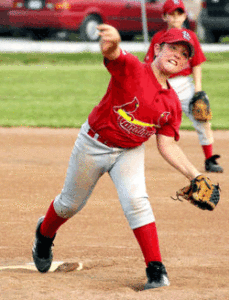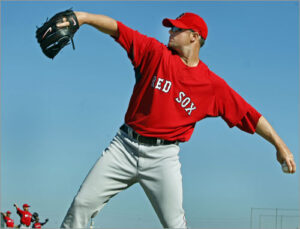Making the Case for Long Toss in a Throwing Program
Long toss may have been scorned by quite a few baseball traditionalists, but I am a big fan of it – and our guys have responded outstandingly to the way we’ve used it. Perhaps it’s just my “1+1=2” logic at work, but I just feel like if you can build up the arm speed to throw the ball a loooonngggg way, then you’ll be able to carry that over to the mound as soon as you get your pitching mechanics dialed in. And, this has certainly been validated with our athletes, as we have loads of professional pitchers who absolutely swear by long toss (both off- and in-season).
So, you can understand why I got excited when my good buddy, Alan Jaeger – a man who has devoted a big chunk of his life to getting long toss “accepted” in the baseball community – was featured in this article at MLB.com about what a difference it makes – including for the Texas Rangers on their road to the World Series a few years ago.
I was, however, not a fan of this paragraph in the article:
“Former Red Sox pitcher Dick Mills has a business built around teaching mechanics and maximizing velocity, and he is a staunch opponent of long tossing. He has released countless YouTube videos angrily decrying this practice. In his latest, ‘How Long Toss Can Ruin Your Pitching Mechanics and Your Arm,’ he says, ‘Why would you practice mechanics that are totally different and will not help a pitcher during a game? And why would you practice throwing mechanics that are clearly more stressful where the arm does most of the work?’”
Taking it a step further, here’s a Dick Mills quote I came across a few years ago:
“Training will not teach you how to apply more force…only mechanics can do that. And pitching is not about applying more effort into a pitch but is about producing more skilled movements from better timing of all the parts. That will help produce more force. No matter how hard you try, you will not get that from your strength training program…no matter who designed it, how much they have promised you it would or your hope that it will be the secret for you.”
While I agree (obviously) on the importance of mechanics and timing, effectively, we’re still being told that long toss, strength training, and weighted balls are all ineffective modalities for developing the pitcher – which leaves us with what, bullpens and stretching? It sounds like every youth baseball practice in the country nowadays – and all we’re getting now are injured shoulders and elbows at astronomical rates. Something isn’t right – and the message is very clear: specificity is a very slippery slope.
On one hand, when it comes to mechanics, you need to throw off the mound to get things fine-tuned to achieve efficiency.
On the other hand, research has shown that arm stress is higher when you’re on the mound (there is less external rotation at stride foot contact with flat ground throwing). Additionally, every pitch that’s thrown is really a step in the direction of sports specialization for a youth baseball player – and something needs to balance that out. Why?
Well, specializing at a young age is destroying kids. As a great study from Olsen et al. showed, young pitchers who require surgery pitched “significantly more months per year, games per year, innings per game, pitches per game, pitches per year, and warm-up pitches before a game. These pitchers were more frequently starting pitchers, pitched in more showcases, pitched with higher velocity, and pitched more often with arm pain and fatigue.” And people think that kid need more work on the mound? What they need are more structured throwing sessions (practice, not competition) and a comprehensive throwing and strength and conditioning program to prepare them for the demands they’ll face.
But those aren’t specific enough, are they?!?!?! Well, let’s talk about specificity a bit more. Actually, let’s read – from renowned physical therapist Gray Cook, a guy who certainly knows a thing or two about why people get injured:
The physical presentation of differently trained bodies often provides a signature of the type and style of activity that developed it. Those who are exclusive in their activities seem more often be molded to their activities, and sometimes actually over-molded. These individuals can actually lose movements and muscles that would make alternate activities much easier.
Specialization can rob us of our innate ability to express all of our movement potential. This is why I encourage highly specialized athletes to balance their functional movement patterns. They don’t so much need to train all movement patterns, they just need to maintain them. When a functional movement pattern is lost, it forecasts a fundamental crack in a foundation designed to be balanced. The point is not that specialization is bad—it only presents a problem when the singular activity over-molds to the point of losing balance.
While there are probably 15-20 awesome messages we can take home from the previous two paragraphs, here’s the big one I want to highlight: it’s our job as coaches to find the biggest window of adaptation a pitcher has and bring it up to speed – while simultaneously keeping other qualities in mind.
If he’s stiff, we work on mobility. If he’s weak, we get him strong. If he’s a mechanical train wreck, we get him more bullpens. If his arm speed isn’t good, we work more on weighted balls and long toss. If you just take a 5-10, 120-pound 9th grader and have him throw bullpens exclusively, he’ll get better for a little bit, and then plateau hard unless you get him bigger and stronger.
How does this work? It’s a little principle called Delayed Transmutation that Vladimir Zatsiorsky highlighted in Science and Practice of Strength Training. Zatsiorsky defines delayed transmutation as “the time period needed to transform acquired motor potential into athletic performance.” In other words, expand and improve your “motor pool” in the off-season, and it’ll be transformed into specific athletic performance when the time is right.
And, as I wrote in The Ultimate Off-Season Training Manual, “the more experienced you are in a given sport, the less time it will take for you to transform this newfound strength and power [and mobility] into sporting contexts.” This is why professional pitchers can find their groove each year MUCH easier than high school pitchers in spite of the fact that they probably take more time off each year (2-3 months from throwing) than the typical overused kid who plays on 17 different AAU teams.
That said, there’s a somewhat interesting exception to this rule: really untrained kids. I’ll give you two examples from the past week alone at Cressey Performance.
We had a high school senior and a high school junior who both just started up their winter throwing programs to prepare for the season.
The first told me that he was sore in his legs after throwing for the first time in his life. Effectively, without throwing a single pitch or really doing any lesson work (or even throwing off a mound), this kid has managed to change the neuromuscular recruitment patterns he uses to throw the baseball. Strength, power, and mobility took care of themselves: delayed transmutation.
The second told me that his arm feels electric. Ask any experienced pitcher, and they’ll tell you that your arm is supposed to feel like absolute crap the first 4-5 days after an extended layoff, but it always gets better. However, when you’re a kid who has gotten more flexible and packed on a bunch of muscle mass, it’s like all of a sudden driving a Ferrari when you’re used to sharing a minivan with Mom: delayed transmutation.
Specificity is important in any sport, but a it really is just the work as far to the right as you can go on the general to specific continuum. Elite sprinters do squats, lunges, Olympic lifts, jump squats, and body weight plyos as they work from left to right on the general-to-specific continuum to get faster. So, why do so many pitching coaches insist that pitchers stay as far to the right as possible? Symbolically, long toss is to pitchers what plyos are to sprinters: specific, but just general enough to make a profound difference.
In a very roundabout way, I’ve made a case for long toss as something that can be classified as beneficial in much the same way that we recognize (well, most of us, at least) that mobility drills, foam rolling, strength training, movement training, and medicine ball drills to be excellent adjuncts to bullpens. In the process of learning to throw the baseball farther, we:
1. push arm speed up
2. train in a generally-specific fashion
3. improve contribution of the lower half
4. realize another specific, quantifiable marker (distance) of progress
5. keep throwing fun
6. train the arm with just enough LESS specificity to help keep pitchers healthy, as compared with mound work
The question then becomes, “Why don’t some pitchers respond well to long toss?” In part 2, I’ll outline the most common mistakes I’ve seen:
When I told Alan Jaeger that I was sending this article out, he graciously offered to set up a 25% off discount code on his Thrive on Throwing DVD set for my readers. This outstanding DVD set thoroughly teaches players and coaches how to approach long tossing, and Alan has also applied a discount to his J-Bands and his Getting Focused, Staying Focused book for pitchers. Here’s a link to the discount page.
Sign up for a Free Copy of the Cressey Performance Post-Throwing Stretches:









